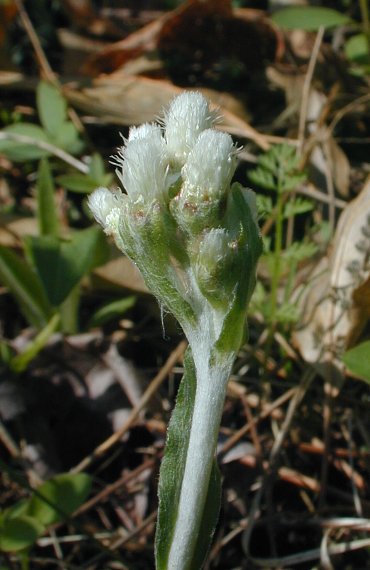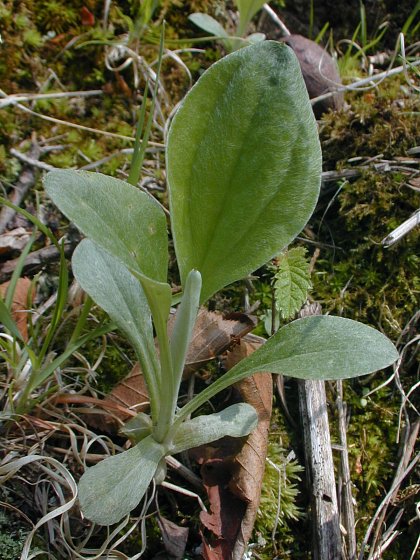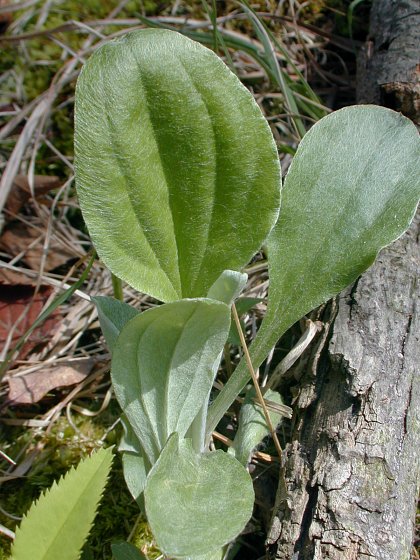Description: This perennial plant is up to 6" tall (rarely taller), consisting of a basal rosette of leaves and an erect stem bearing the inflorescence. Species in this genus are dioecious, with individual plants bearing either staminate (male) or pistallate (female) flowers. The basal leaves are up to 3½" long and 2" across; they are obovate in shape with long petioles and their margins are smooth. Mature basal leaves have 3-5 conspicuous veins. The upper surfaces of these leaves are light to medium green and glabrous to appressed-hairy, while their lower surfaces are whitish green and densely appressed-hairy. Sometimes basal leaves become more glabrous with age. During the spring, a central stem develops from the basal leaves. This central stem is densely covered with appressed white hairs; along its length, there are a few alternate leaves. These leaves clasp the stem and they are erect or ascending. Individual alternate leaves are up to 1½" long, narrowly lanceolate or elliptic in shape, and smooth to undulate; they tend to be more hairy than the basal leaves. At the apex of the central stem is a small cluster of about 3-6 staminate or pistillate flowerheads.

The flowerheads are about ¼–½" long and a little less across; they have phyllaries (floral bracts) at their bases that are light green and hairy, otherwise they consist of white disk florets. The staminate florets have brownish tubular anthers, while the pistillate florets are fluffy white from an abundance of styles. The blooming period occurs during mid- to late spring, lasting about 2-3 weeks. There is no noticeable floral scent. While the flowers are capable of cross-pollination by means of either wind or insects, they are also capable of self-pollination. Afterwards, the florets are replaced by achenes that resemble small brown nutlets with white resinous dots, to which small tufts of white hair are attached. They are distributed by the wind. The flower-bearing part of the plant dies down during the summer, but the rosette of basal leaves persists. Occasionally, this plant forms stolons that can take root a short distance from the mother plant, forming clonal offsets. There is a strong tendency to form colonies, sometimes consisting of all staminate or pistillate plants.

Cultivation:
The
preference is full sun to light shade and average to dry conditions.
This plant often flourishes in poor soil that contains sand,
rocky material, or clay. Young growth during the spring is rarely
bothered by disease, although the semi-evergreen basal leaves often
become discolored and withered with age.
Range & Habitat:
Plantain-Leaved Pussytoes has been found in most of the counties of
Illinois (see Distribution
Map),
where it is both native and common. Habitats include hill
prairies, openings in upland forests, wooded slopes, bluffs,
limestone glades, areas along woodland paths, disturbed open woodlands,
thickets, pastures, and abandoned fields. Both sandy and non-sandy
areas can provide suitable habitat. This little plant favors areas with
reduced ground competition that are partially sunny. Occasional
wildfires are probably beneficial as this reduces competition from
woody vines and shrubs.

Faunal Associations: The flowers are visited primarily by small bees and flies. Among the bees, this includes Andrenid bees, Halictid bees, and cuckoo bees (Nomada spp.), while fly visitors consist primarily of Syrphid flies and, to a lesser extent, flesh flies, blow flies, Muscid flies, and others. Insects that feed on Plantain-leaved Pussytoes and other Antennaria spp. (Pussytoes) include larvae of the fly Chromatomyia syngenesiae (Chrysanthemum Leafminer), gall-forming larvae of the flies Aspondylia antennariae (Everlasting Bud Midge) and Rhopalomyia antennariae (Pussytoes Bud Midge), larvae of Tebenna gnaphaliella (Everlasting Tebenna Moth), caterpillars of the butterfly Vanessa virginiensis (American Painted Lady), and the aphid Pleotrichophorus antennarius. To a limited extent, the Bobwhite Quail eats the seeds, while the White-Tailed Deer and Cottontail Rabbit browse on the foliage.

Photographic
Location:
The photograph of the pistillate flowerheads was taken along a woodland
path at Busey Woods in Urbana,
Illinois, while the remaining photographs were taken at a
hilly woodland in east-central Illinois.
Comments:
Plantain-leaved Pussytoes can be readily distinguished from Antennaria
neglecta
(Field Pussytoes) by its basal leaves. The latter species has basal
leaves that are single-veined and more narrow. Field Pussytoes is also
more typical of open habitats, rather than woodland areas. Because
Plantain-leaved Pussytoes is a rather variable species, it is often
divided into different varieties or subspecies; some authorities even
divide it into different species (Mohlenbrock, 2002). These
distinctions take into consideration the length of phyllaries (floral
bracts) in pistillate (female) plants, and the hairiness or shape of
the basal leaves. No attempt has been made to make such fine
distinctions here. Some authorities state that these plants are
wind-pollinated, while others emphasize the role of insects in
cross-pollination.